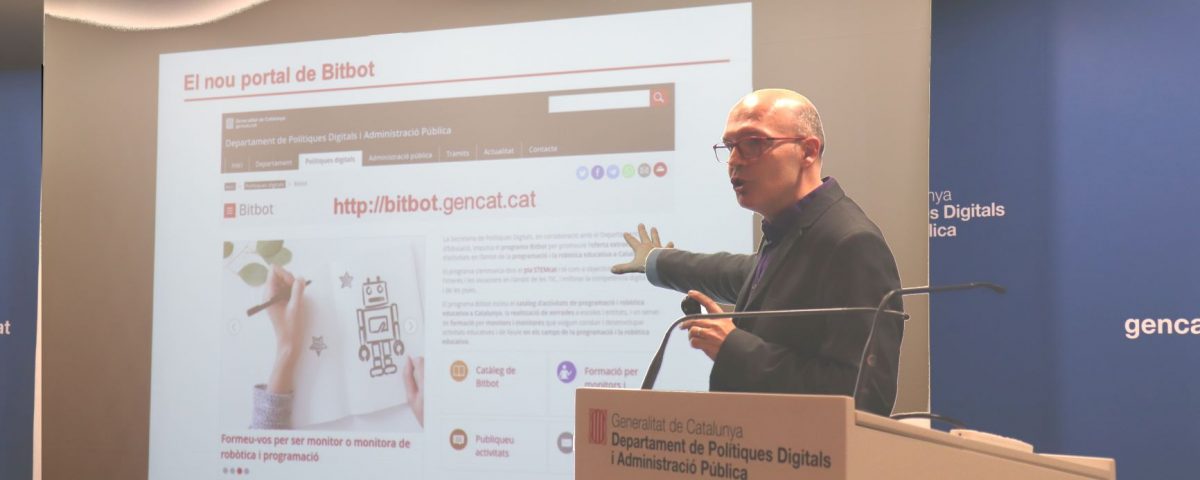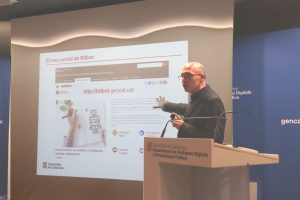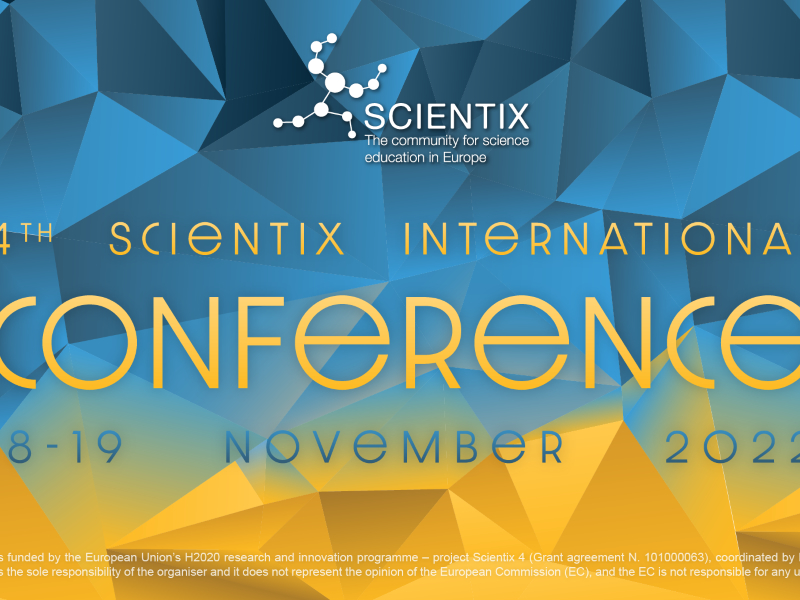Francesc Rambla: “Different STE(A)M subjects are fundamental to make these proposals reach a wider audience”
Francesc Rambla: “Different STE(A)M subjects are fundamental to make these proposals reach a wider audience”


Francesc Rambla is a technical engineer in telecommunications. He has worked for more than twenty years as a consultant in the field of information and communication technologies, both in the public and private sectors, an activity that he has combined with teaching. Since 2005 he has been working for the Generalitat of Catalonia as a Technician in charge of technological vocation projects to promote technological vocations, educational technologies and free software. Our partner Colectic spoke with him about the situation of the maker movement and STE(A)M education in Catalonia.
- What is the situation of maker movement and STE(A)M education in Catalonia, in your opinion – initial, incipient, in development, or in consolidation?
There is always a room for improvement but I think that in Catalonia there is a very wide consolidated offer of extracurricular and leisure STE(A)M activities. This offer is often particularly focused on the field of educational robotics, which, in many cases, incorporates a maker component. This means that other STE(A)M disciplines, such as biology, chemistry, mathematics or certain branches of physics, are under-represented in this offer and, as a consequence, although these activities have a very convinced audience, it is difficult to expand it.
On the other hand, the reality is that Catalonia is very diverse and that this offer is not uniform everywhere. There are still many regions where the only possibility to access this offer is through online proposals or specific activities that are offered, very often, to the orbit of educational centers. So I think we are not bad, but could be much better.
- Which strategies do you think can best serve to extend the scope of this movement in Catalonia?
In my opinion, the different specialties are essential to extend these proposals to a wider audience. Announcing a workshop or an activity with the word “robotics” immediately generates the rejection from a part of the target audience. All the experts tell us that STE(A)M activities have to be introduced through contextualized proposals in aspects that interest or concern young people and children.
For example, if we propose an “Underwater Robotics” workshop, we will attract a very convinced audience, but if we contextualize this workshop and call it “Let’s save the sea! We build robots to eliminate plastics”, surely we can attract a part of the public that otherwise wouldn’t come close.
In any case, this means that the conceptualization and design of the proposals is more complex and, therefore, more expensive. It is not enough to have a beautiful idea, you have to work on it, adapt it to different ages, social contexts, have trained personnel specialized in social stimulation, but also in STE(A)M subjects. Wow, all this is not easy!
- Do we have leading initiatives in Catalonia on STE(A)M? Any project, resource or experience that you want to highlight in this respect?
We do have expert groups that offer relevant activities and proposals, but, unfortunately, it becomes very difficult to make them grow and reach a wider audience. I will cite two initiatives from different disciplines, which, despite being successful, we cannot consider them to be benchmarks because the impact they achieve is small.
The first is the Museum of Mathematics of Catalonia (MMACA). It is an infrastructure managed by a teachers’ association that is economically viable, that has an offer for teachers, for families and for compulsory education school groups.
However, it has collapsed. Every year it receives about 40,000 students and cannot accept more! This represents only 4% of the students in public education. It would be ideal for students to be able to work on mathematics with the strategies presented to the MMACA, not one day in the course, but at least one day a week throughout the course. Surely, in a few years, such an action would show results.
The other initiative that I would like to show in value is the Technovation Challenge. This proposal is important, because it is for girls. The idea is that girls develop an entrepreneurship project around a mobile application that responds to a social concern that they have detected themselves.
The activity includes all the ingredients to lead it to success: interdisciplinarity (it is fundamentally technological in nature, but has communicative, aesthetic, social components, etc,), the ideas of the participants themselves when looking for a problem, lack or need to solve or cover, and, finally, the possibility that this initiative materialized in real applications.
All of this makes this initiative a success, but it reaches a not very significant part of the school-age population and has a low impact.
- The Government of Catalonia is leading through initiatives such as Bitbot.cat. What do you think are the strengths and weaknesses of this initiative? Creus that is exportable to other countries, especially considering those of the European Union? Do you use any platform or channel to share and dialogue with other outside communities?
Bitbot is an initiative that we launched four years ago to promote the extracurricular offer of programming activities and educational robotics. The name of the initiative plays with the terms ‘bit’ (basic unit of information and basis of binary computing) and ‘bot’ (contraction of the term robot). We chose this name because, in addition to the meaning we can give it, we thought it conveyed something fun and attractive for children.
Bitbot consists of three lines of work: the catalog of extracurricular programming and educational robotics activities in Catalonia, the training programme for monitors of this type of activities and, finally, a set of dissemination actions. The objectives of Bitbot are to improve children’s digital competence and, through an approach to the world of technology, to seek new technological vocations.
It is evident that participation in educational robotics and programming workshops opens a window, that of computational thinking, which otherwise very often remains closed. In this sense, the program may not improve digital competence, but it certainly complements it.
Regarding vocations, given that the public of the programme is between 8 and 14 years old, it is still too early to see the fruits, but we are convinced that the people who have participated continuously in these activities topics, they will have a sensitivity towards technology in the future.
Bitbot is easily exportable in other countries or contexts, despite the fact that in each case it would have to be evaluated which are the most appropriate lines of work and what the best way to carry them out.
The Generalitat of Catalonia, through the Departments of Digital Policies and Public Administration, and of Education, is part of the EU STEM Coalition, which is a meeting space in which public administrations, platforms and universities from various member states of the EU.
- Do you think that STE(A)M helps or hinders the work (and the gender gap) in technical-scientific vocations?
Before answering this question, I try to explain what I understand by ‘STEM’ and ‘STE(A)M’, because this will help me later to develop the answer.
In my view, when we talk about STE(A)M we refer to the set of strategies or methodologies to work within the educational field (formal or non-formal) of mathematics, scientific and technological subjects, in an integrated way – that is, STEM subjects. There is no unanimity in the meaning of ‘A’ in STE(A)M, it is often attributed to “Arts”, but I like a more holistic conception and I attribute the concept “all” to it, in the sense that any other subject is good for STEM work.
Following this view, which does not have to be shared, there is a set of studies and professions that we could fit within the STEM concept, while any study or profession would be within STE(A)M field.
This is the reason why it is very difficult for me to pose, from the point of view of the gender gap, all STEM studies or professions, because the data tell us that the casuistry is very heterogeneous. In Catalonia, for example, while in ICT studies the percentage of girls is around 10%, in biological sciences studies it is above 65%.
In any case, as I have already said when referring to extracurricular activities, a good STE(A)M strategy is essential to promote vocations and, because it is a good strategy, learning all subjects has to be done. It should be done in an integrated way and in an understandable context. Otherwise, we will end up repeating the same errors and obtaining the same results.
- Do you think that this type of activities, projects and experiences can serve to democratize access to technology or, on the other hand, is there a risk of generating elitist exclusivity spaces?
I think that the most effective way to guarantee universal access to technology is through compulsory education and, at least in our case, free education. Any other strategy, project or initiative can also help reach the public, but carries a high risk of worsening the social and economic gap.
- What is the role that the culture of the commons can play in these initiatives? Do you know the Catalan initiatives related to STE(A)M and the commons?
Throughout this interview I have been thinking about the importance of contextualizing learning to reach a wider audience. I am convinced that this is the key.
Developing interdisciplinary pedagogical proposals, for different levels and rhythms of learning, designing the evaluation and establishing the links with the basic competences that all citizens should have, is very difficult and, therefore, very expensive. It is an iterative, trial and error process that, from my point of view, is available to very few people.
The world of the commons and free knowledge has shown that co-creation works. Projects such as GNU / Linux or Viquipèdia are examples, therefore, my opinion is that we must work in this line in the construction of educational proposals.
Later, if necessary, publishers will come to package them and offer them in print or embedded in digital platforms, but the collective effort to build them has to remain accessible and public. The best guarantee to achieve this are open and free licenses.
There are some initiatives that promote the publication of proposals with free licenses, generally creative-commons, but I think this is not enough. You have to offer support so that other people can contribute and help improve them.
In this sense, I would highlight a proposal that is developed within the framework of mSchools, a programme to bring mobile technologies closer to education of the Mobile World Capital Barcelona Foundation that is developed in collaboration with the Generalitat of Catalonia, the Barcelona City Council and the GSMA.
EduHack is being developed within mSchools, an initiative that proposes a co-creation process based on the Design-Thinking methodology to build educational proposals. These proposals are documented and published under free and open licenses. From my point of view, the only downside to this proposal is that it is not yet critical enough and this makes it difficult for there to be a large community to iterate and refine the proposals.
By Colectic


